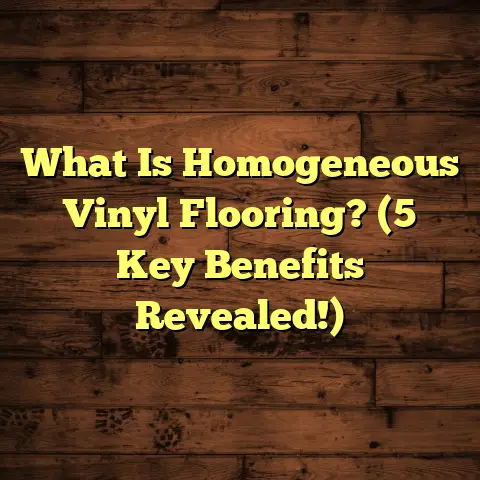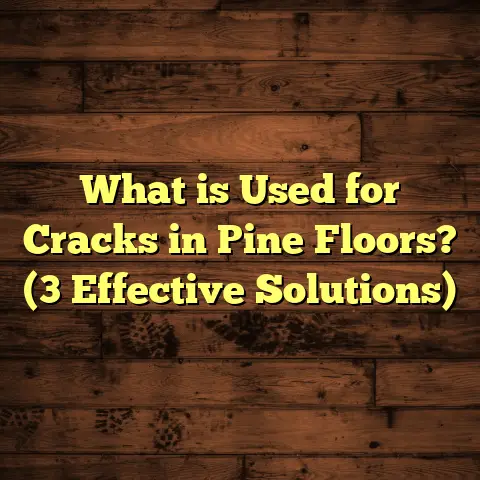What is a No Wax Floor? (5 Reasons You’ll Love This Trend)
Ever walked into a room and thought,
“Wow, this floor looks amazing,”
but then noticed it’s not glossy or shiny like floors you’re used to?
That’s probably a no wax floor.
I remember when I first heard about no wax floors,
I was skeptical. How can a floor without wax look good and last long?
After years of working with all kinds of flooring, I’ve learned a lot about why no wax floors are becoming such a popular choice.
Let me take you through what they are, why they matter, and why you might just love this trend.
What is a No Wax Floor?
Simply put, a no wax floor is a type of flooring that doesn’t require traditional wax coatings to maintain its shine or protection.
Unlike older floor maintenance methods where you had to apply layers of wax regularly to keep the floor looking good, no wax floors are designed to resist dirt, scuffs, and wear without that extra step.
Back in the day, floors like vinyl composition tile (VCT) or linoleum needed waxing to create that protective layer.
No wax floors have a factory-finished surface that’s tough and easy to clean without the hassle of waxing.
That means less maintenance time and fewer chemicals floating around your home or business.
In my experience, no wax floors usually come in commercial buildings, schools, hospitals, or even homes where heavy foot traffic demands durability without constant upkeep.
These floors use advanced polymer finishes that resist scratches and stains better than traditional wax coatings.
How No Wax Floors Work
The secret lies in the finish.
Instead of wax, these floors have a urethane or acrylic coating applied during manufacturing.
This finish hardens and bonds tightly with the floor surface.
It doesn’t peel or wear off easily and provides a smooth, glossy look right out of the box.
I remember installing no wax flooring in a local community center where staff told me they spent hours every week waxing the old floors.
After switching to no wax flooring, their cleaning time dropped by 70%, which was huge for their busy schedule.
This isn’t just luck — it’s science. The polymer finishes create a strong, flexible barrier that protects the floor beneath while allowing easy cleaning.
Different Types of No Wax Floors
No wax finishes aren’t limited to just one kind of flooring.
Here are some popular types:
- Vinyl Composition Tile (VCT) with no wax finish: Traditional VCT typically needed waxing; now some brands offer factory-finished options.
- Luxury Vinyl Tile (LVT): Many LVT products come with no wax technology built in.
- Rubber Flooring: Often used in gyms or hospitals, rubber floors usually don’t need waxing.
- Epoxy Floors: These coatings provide an ultra-durable finish without waxing.
- Concrete with Sealers: Sealed concrete floors don’t require waxing and can achieve a sleek look.
Each type has its own benefits and best use cases, which I’ll get into later.
Why No Wax Floors Are Gaining Popularity
Honestly, the no wax trend took me by surprise at first.
I used to think waxing was just part of the deal with certain floors.
But when I dove deeper and saw the benefits firsthand — from clients saving time and money to better health outcomes — I couldn’t ignore it anymore.
Let me share five major reasons why I think you’ll love no wax flooring too.
1. Less Maintenance Means More Free Time
Waxing floors isn’t just messy — it eats up your time.
You’ve got to strip old wax, apply new coats, buff it out, and hope it dries properly before anyone walks on it.
I’ve been called into buildings where the janitorial staff spend entire weekends stripping and rewaxing floors. It’s exhausting work and sometimes dangerous because of the chemicals involved.
No wax floors cut out all that hassle.
You just mop or clean as usual. The factory finish stays intact for years, reducing labor costs significantly.
Here’s a real eye-opener: Data from commercial cleaning services shows that switching to no wax flooring can reduce maintenance labor by up to 60%.
A client of mine who runs a daycare center told me they went from spending 10 hours a week on floor care down to just 3 hours with no wax floors. That’s valuable time they could spend focusing on the kids instead.
2. Durability You Can Count On
You might be wondering if skipping wax means less protection. Actually, no wax floors can be tougher than their waxed counterparts.
The polymer finishes are resistant to scratches, scuffs, and chemical spills.
One hospital I worked with switched their high-traffic hallways to no wax flooring. Over five years, floor damage dropped by nearly 50% compared to areas with traditional waxed VCT.
I’ve seen no wax floors that looked brand new even after years of heavy use — something that’s hard to maintain with floors that need constant recoating.
What’s more, these finishes often come with warranties extending 5-10 years for wear resistance — far better than traditional wax coatings.
3. Eco-Friendly Benefits You Can Feel Good About
Wax stripping involves harsh chemicals that aren’t great for the environment or indoor air quality.
No wax floors eliminate the need for stripping and waxing chemicals entirely. This means fewer harmful fumes and less hazardous waste to dispose of.
Some clients who care deeply about sustainability have been thrilled by this aspect.
According to an environmental study by a major flooring association, facilities switching to no wax flooring reduced their chemical use by over 80%, which lowers indoor pollution and chemical runoff.
Personally, I like knowing I’m recommending an option that’s safer for kids playing on the floor and workers who clean every day.
4. Better Indoor Air Quality for Everyone
Traditional waxing releases volatile organic compounds (VOCs) during application and stripping.
These VOCs can cause headaches, respiratory irritation, and other health issues — especially in places like schools or healthcare facilities where people spend hours daily.
No wax finishes are low-VOC or VOC-free, improving indoor air quality significantly.
One school district I worked with reported fewer complaints about headaches and allergies after switching classrooms to no wax flooring.
This benefit alone has convinced many facility managers I know to switch over quickly.
5. More Styles Than Ever Before
If you think “no wax” means dull or boring floors — think again!
These floors come in tons of styles, colors, and textures — from wood-look vinyl planks to stylish tile patterns.
I installed no wax luxury vinyl tile (LVT) in a trendy café recently; the owner loved how realistic the wood grain looked without any shine or slipperiness from wax.
Plus, since the finish is factory applied, the color stays vibrant longer without yellowing or fading like some waxed surfaces can.
Challenges I’ve Encountered With No Wax Floors
Of course, nothing is perfect. No wax floors have some challenges worth mentioning based on my experience.
Initial Cost Can Be Higher
No wax flooring sometimes costs more upfront than traditional VCT that requires waxing.
The better finishes and manufacturing process add to the price.
I had a client hesitate because their initial quote was 15-20% higher than their usual budget.
But after factoring in lower maintenance costs over time — including labor savings and fewer supplies — it quickly made financial sense.
It’s like paying more now but saving thousands in maintenance over several years.
Surface Sensitivity Requires Proper Care
Though durable, some no wax finishes can be vulnerable to abrasive scrubbing or harsh cleaners that damage the finish.
In one unfortunate incident, a janitor accidentally used an aggressive cleaner on a no wax floor which dulled the surface noticeably.
Proper training of cleaning staff is crucial to fully benefit from these finishes.
Using pH-neutral cleaners recommended by manufacturers keeps the finish intact longer.
Repair Can Be Tricky
If the finish does get damaged deeply — say from heavy furniture dragging or sharp objects — repairing no wax floors can be harder compared to simply waxing over scratches on traditional floors.
In some cases, full plank or tile replacement is needed rather than spot fixes.
That said, good quality no wax floors rarely need repairs if cared for properly.
My Personal Stories With No Wax Flooring
I’ve installed no wax flooring in dozens of projects — schools, offices, homes — each with unique stories worth sharing.
The Senior Living Facility That Breathed Easier
One project stands out: a senior living center where residents complained about chemical smells from waxing routines every week.
We switched them over to no wax flooring throughout common areas.
The difference was almost instant — residents noticed fresher air and fewer headaches within days.
Staff reported easier cleaning routines too, freeing up time for resident care instead of floor scrubbing.
The Busy School That Cut Costs Dramatically
Another client was a public school struggling with budgeting for custodial staff wages and supplies for waxing VCT hallways twice monthly.
We advised them on switching to no wax vinyl tile with factory finish.
Within a year:
- Custodial hours spent on floor care dropped by 50%
- Supply expenses for cleaners and strippers dropped by 65%
- Student complaints about slippery floors decreased
The principal told me they redirected savings toward new classroom technology instead of maintenance headaches.
The Trendy Café That Needed Style Without Fuss
A local café wanted beautiful wood-look flooring but hated how slippery waxed floors could get when wet.
We installed no wax luxury vinyl plank with textured surface for grip plus stunning aesthetics.
The owner said it perfectly matched their vibe while making cleanup after busy days simple and safe for customers.
Installation Tips for No Wax Flooring
If you’re thinking of installing no wax flooring yourself or hiring pros like me, here are some tips I’ve learned along the way:
Choose Quality Products
Not all no wax floors are created equal. Look for products with strong manufacturer warranties and proven durability ratings.
Brands offering urethane or enhanced acrylic finishes tend to last longer without recoating.
Prepare Subfloor Thoroughly
A smooth, clean subfloor ensures proper bonding of tiles or planks and prevents premature wear or bubbling.
I always recommend moisture testing before installation as excess moisture can ruin even the best finishes over time.
Follow Manufacturer Instructions Exactly
From adhesive types to installation temperatures — following guidelines avoids costly mistakes later.
Train Cleaning Staff Early
Make sure everyone who cleans knows what products are safe and what tools to avoid damaging finishes.
How No Wax Floors Compare With Other Flooring Types
Let’s compare no wax floors briefly against some popular alternatives:
| Flooring Type | Maintenance Needed | Durability | Cost Range | Appearance Options | Eco-Friendliness |
|---|---|---|---|---|---|
| Traditional Waxed VCT | Regular stripping & waxing | Moderate | Low | Limited | Lower (due to chemicals) |
| No Wax Vinyl Tile | Simple mopping | High | Medium-High | Wide variety | Higher |
| Hardwood | Occasional refinishing | High | High | Classic & natural | Depends on source |
| Laminate | Easy cleaning | Moderate | Medium | Many designs | Moderate |
| Carpet | Regular vacuum & cleaning | Low-Moderate | Low-Medium | Many colors | Typically lower |
No wax vinyl stands out for ease-of-care combined with durability and style versatility — especially in commercial or busy residential settings.
Maintenance Tips I Swear By for No Wax Floors
Even though these floors don’t need waxing, proper care still matters:
- Use pH-neutral cleaners approved for your specific floor type.
- Avoid abrasive scrubbers or steel wool pads.
- Place mats at entrances to reduce dirt tracked inside.
- Use felt pads under furniture legs.
- Clean spills promptly to avoid staining.
- Schedule periodic deep cleanings using manufacturer-recommended methods.
- Avoid harsh chemicals like bleach or ammonia-based cleaners.
- Don’t flood floors with water; mop damp is best.
- Consider professional cleaning every few years depending on traffic level.
These small habits can extend your floor’s life and keep it looking fresh for years.
Common Questions About No Wax Flooring
Q: Can I apply wax over a no wax floor?
A: It’s usually not recommended since these floors have factory-applied finishes designed to resist dirt and scuffs without waxing. Adding wax can cause build-up or dullness.
Q: How long does a no wax floor last?
A: With proper care, you can expect 5-10 years or more before needing refinish or replacement depending on traffic levels.
Q: Are no wax floors slippery?
A: Some finishes have anti-slip textures; others may be smooth but generally safer than freshly waxed floors which can be slick when wet.
Q: Can I install no wax flooring myself?
A: Yes! Many DIY-friendly options exist but make sure you understand subfloor prep and adhesive usage well before starting.
Final Thoughts — Why You Might Love No Wax Flooring
If you want flooring that saves time, cuts costs over time, improves indoor air quality, and still looks fantastic — no wax floors should be high on your list.
Are you tired of spending your weekends stripping and waxing? Want durable surfaces that stand up to life’s messes without constant fuss? This option might be your answer.
Feel free to ask me about specific products or how no wax flooring might work in your space. I’m happy to share more stories or help you figure out if this option fits your needs!
If you want help calculating installation costs or comparing materials for your next project, I often use FloorTally — it’s an easy tool for budgeting based on local prices and options. Just let me know!





